Abstract
Hybridization of human T cells with an azaguanine-resistant human T cell line gave rise to T hybrid cell lines secreting several immunoregulatory molecules. Analyses of karyotypes, HLA phenotypes, and other surface phenotypes, such as T-cell-specific antigens or receptors for sheep erythrocytes and the patterns of mitogen responsiveness confirmed that the hypoxanthine/aminopterin/thymidine-resistant cell lines were human T-T hybridomas. One of the established hybrid clones (24-A) secreted human interleukin-2 (IL-2). The culture supernatants induced the proliferation of concanavalin A-stimulated murine T cells and supported the proliferation of an IL 2-dependent human cytotoxic T-cell line. In a clone (38-B) that did not show any IL-2 activity in culture supernatants, the addition of macrophages induced IL-2 production in the presence of phytohemagglutinin, suggesting that interleukin-1 induced IL-2 production in T hybrid cells. Hybrid cells secreting killer helper factor were also established. The culture supernatants from this clone, 55-A, helped the induction of cytotoxic T cells against UV-treated human B-blastoid cells but did not show any IL-2 activity.
Full text
PDF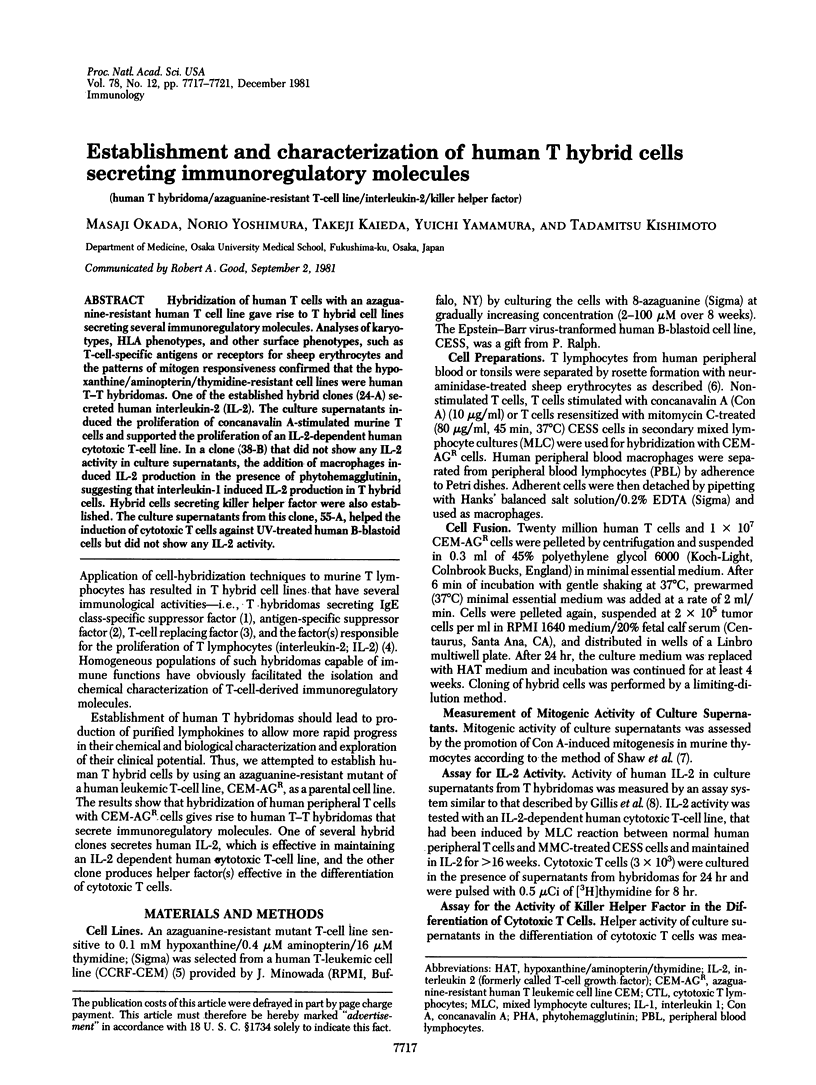
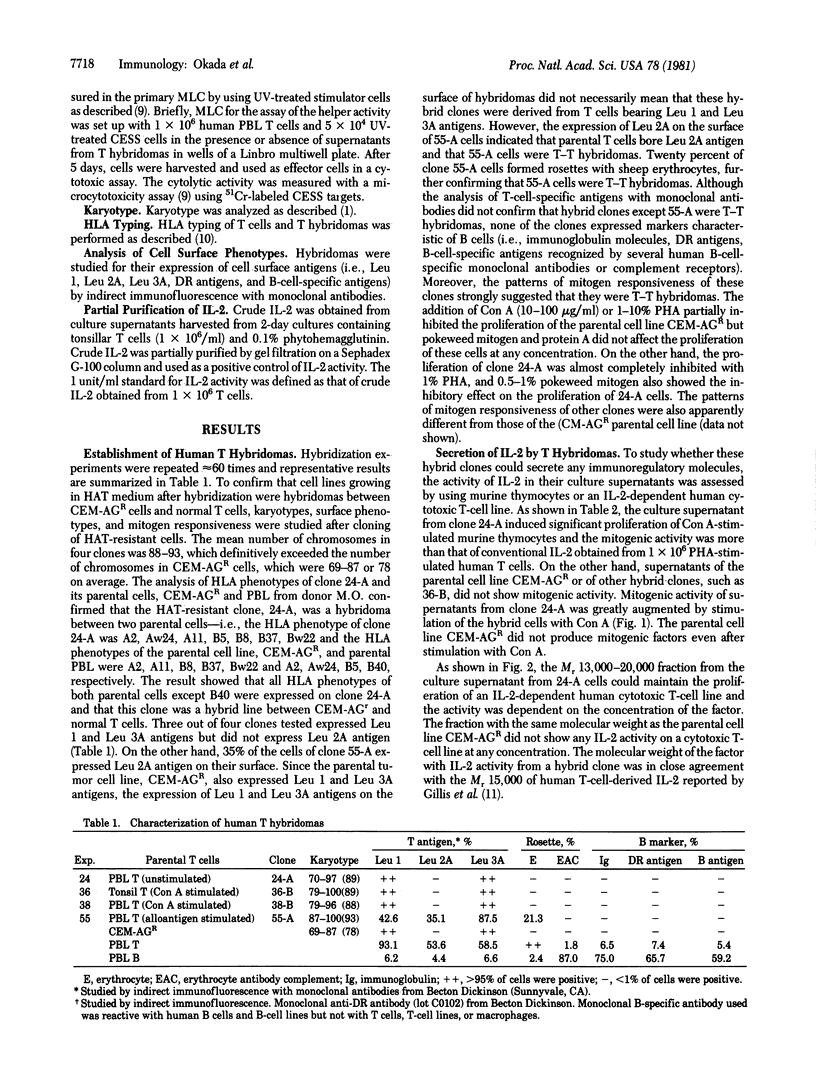
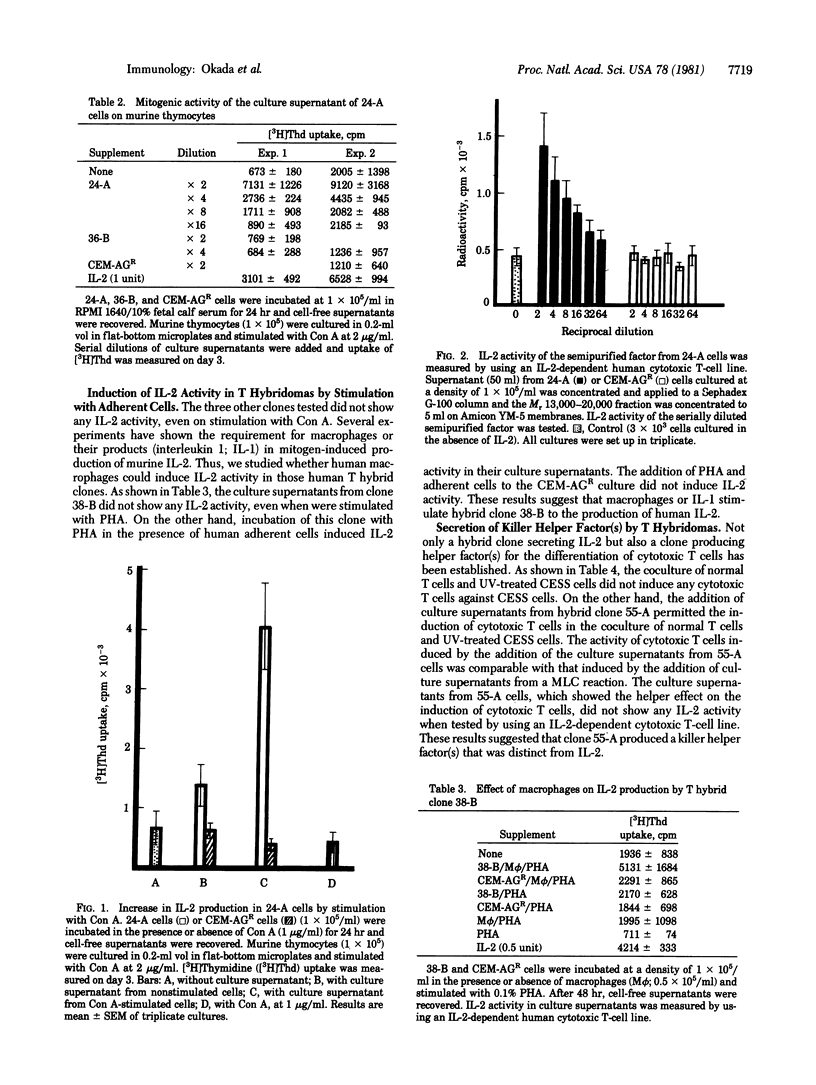
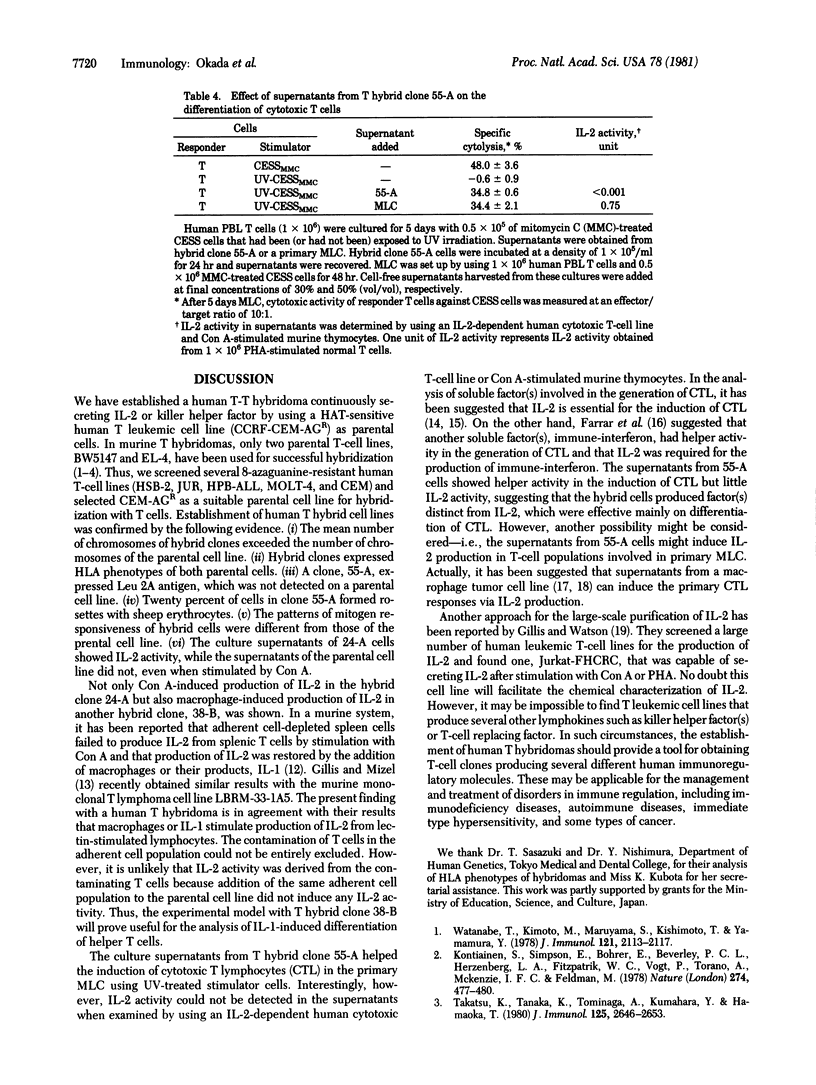
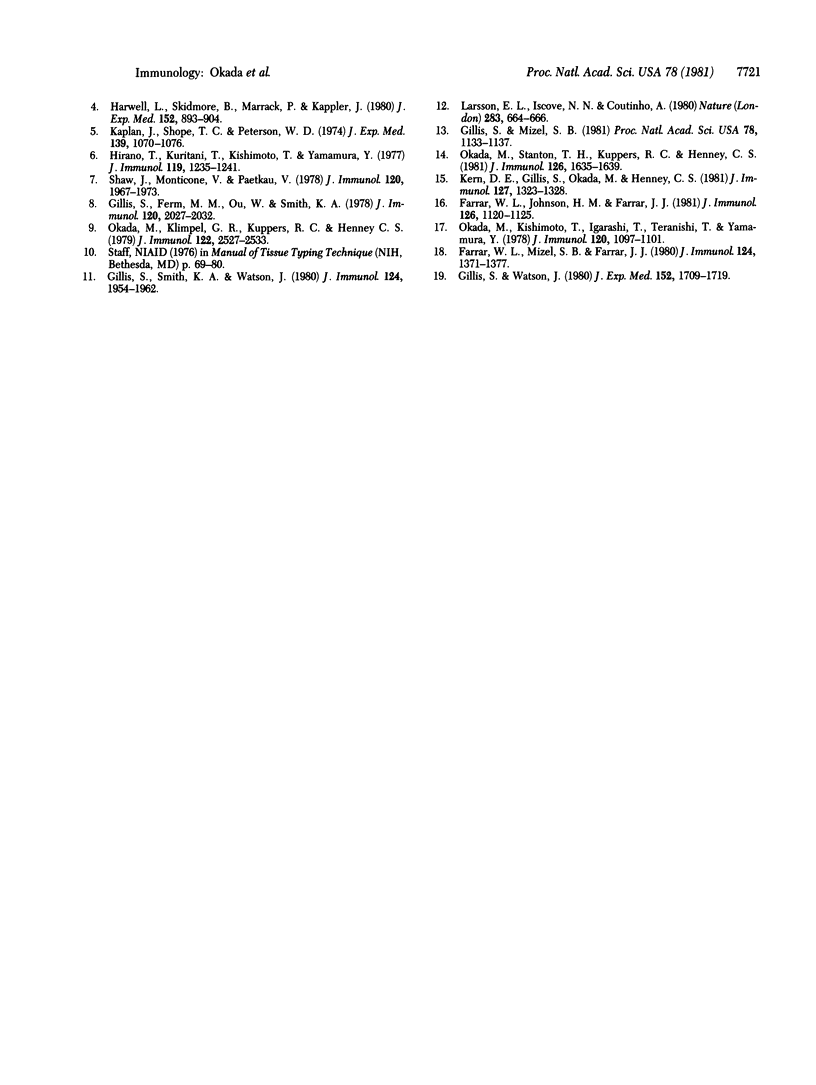
Selected References
These references are in PubMed. This may not be the complete list of references from this article.
- Farrar W. L., Johnson H. M., Farrar J. J. Regulation of the production of immune interferon and cytotoxic T lymphocytes by interleukin 2. J Immunol. 1981 Mar;126(3):1120–1125. [PubMed] [Google Scholar]
- Farrar W. L., Mizel S. B., Farrar J. J. Participation of lymphocyte activating factor (Interleukin 1) in the induction of cytotoxic T cell responses. J Immunol. 1980 Mar;124(3):1371–1377. [PubMed] [Google Scholar]
- Gillis S., Ferm M. M., Ou W., Smith K. A. T cell growth factor: parameters of production and a quantitative microassay for activity. J Immunol. 1978 Jun;120(6):2027–2032. [PubMed] [Google Scholar]
- Gillis S., Mizel S. B. T-Cell lymphoma model for the analysis of interleukin 1-mediated T-cell activation. Proc Natl Acad Sci U S A. 1981 Feb;78(2):1133–1137. doi: 10.1073/pnas.78.2.1133. [DOI] [PMC free article] [PubMed] [Google Scholar]
- Gillis S., Smith K. A., Watson J. Biochemical characterization of lymphocyte regulatory molecules. II. Purification of a class of rat and human lymphokines. J Immunol. 1980 Apr;124(4):1954–1962. [PubMed] [Google Scholar]
- Gillis S., Watson J. Biochemical and biological characterization of lymphocyte regulatory molecules. V. Identification of an interleukin 2-producing human leukemia T cell line. J Exp Med. 1980 Dec 1;152(6):1709–1719. doi: 10.1084/jem.152.6.1709. [DOI] [PMC free article] [PubMed] [Google Scholar]
- Harwell L., Skidmore B., Marrack P., Kappler J. Concanavalin A-inducible, interleukin-2-producing T cell hybridoma. J Exp Med. 1980 Oct 1;152(4):893–904. doi: 10.1084/jem.152.4.893. [DOI] [PMC free article] [PubMed] [Google Scholar]
- Hirano T., Kuritani T., Kishimoto T., Yamamura Y. In vitro immune response of human peripheral lymphocytes. I. The mechanism(s) involved in T cell helper functions in the pokeweed mitogen-induced differentiation and proliferation of B cells. J Immunol. 1977 Oct;119(4):1235–1241. [PubMed] [Google Scholar]
- Kaplan J., Shope T. C., Peterson W. D., Jr Epstein-barr virus-negative human malignant T-cell lines. J Exp Med. 1974 May 1;139(5):1070–1076. doi: 10.1084/jem.139.5.1070. [DOI] [PMC free article] [PubMed] [Google Scholar]
- Kern D. E., Gillis S., Okada M., Henney C. S. The role of interleukin-2 (IL-2) in the differentiatin of cytotoxic T cells: the effect of monoclonal anti-IL-2 antibody and absorption with IL-2 dependent T cell lines. J Immunol. 1981 Oct;127(4):1323–1328. [PubMed] [Google Scholar]
- Kontiainen S., Simpson E., Bohrer E., Beverley P. C., Herzenberg L. A., Fitzpatrick W. C., Vogt P., Torano A., McKenzie I. F., Feldmann M. T-cell lines producing antigen-specific suppressor factor. Nature. 1978 Aug 3;274(5670):477–480. doi: 10.1038/274477a0. [DOI] [PubMed] [Google Scholar]
- Larsson E. L., Iscove N. N., Coutinho A. Two distinct factors are required for induction of T-cell growth. Nature. 1980 Feb 14;283(5748):664–666. doi: 10.1038/283664a0. [DOI] [PubMed] [Google Scholar]
- Okada M., Kishimoto T., Igarashi T., Teranishi T., Yamamura Y. LPS-or 8Br-cyclic AMP-induced production of T cell-activating factor(s) in macrophage tumor cell line J774.1. J Immunol. 1978 Apr;120(4):1097–1101. [PubMed] [Google Scholar]
- Okada M., Klimpel G. R., Kuppers R. C., Henney C. S. The differentiation of cytotoxic T cells in vitro. I. Amplifying factor(s) in the primary response is Lyt 1 + cell dependent. J Immunol. 1979 Jun;122(6):2527–2533. [PubMed] [Google Scholar]
- Okada M., Stanton T. H., Kuppers R. C., Henney C. S. The differentiation of cytotoxic T cells in vitro. IV. Interleukin-2 production in primary mixed lymphocyte cultures involves cooperation between Qa-1+ and Qa-1- "helper" T cells. J Immunol. 1981 Apr;126(4):1635–1639. [PubMed] [Google Scholar]
- Shaw J., Monticone V., Paetkau V. Partial purification and molecular characterization of a lymphokine (costimulator) required for the mitogenic response of mouse thymocytes in vitro. J Immunol. 1978 Jun;120(6):1967–1973. [PubMed] [Google Scholar]
- Takatsu K., Tanaka K., Tominaga A., Kumahara Y., Hamaoka T. Antigen-induced T cell-replacing factor (TRF). III. Establishment of T cell hybrid clone continuously producing TRF and functional analysis of released TRF. J Immunol. 1980 Dec;125(6):2646–2653. [PubMed] [Google Scholar]
- Watanabe T., Kimoto M., Maruyama S., Kishimoto T., Yamamura Y. Regulation of antibody response in different immunoglobulin classes. V. Establishment of T hybrid cell line secreting IgE class-specific suppressor factor. J Immunol. 1978 Nov;121(5):2113–2117. [PubMed] [Google Scholar]


